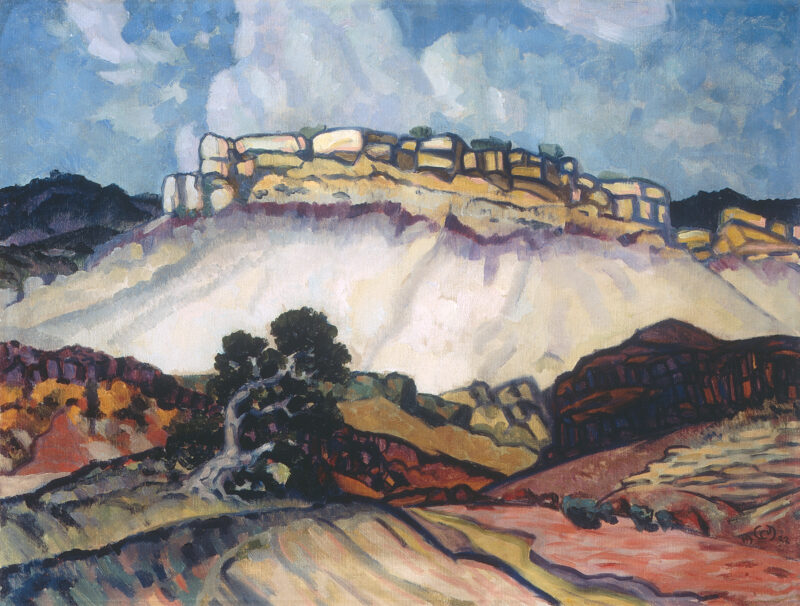
White Mesa – 1922
Jonson, Raymond
1922
Artwork Information
-
Title:
White Mesa – 1922
-
Artist:
Jonson, Raymond
-
Artist Bio:
American, 1891–1982
-
Date:
1922
-
Medium:
Oil on canvas
-
Dimensions:
25 1/8 x 33 1/4 inches
-
Credit Line:
Wichita Art Museum, Gift of Merleyn and Don Calvin
-
Object Number:
1977.109
-
Display:
Not Currently on Display
About the Artwork
In New Mexico, Raymond Jonson found a permanent artistic and spiritual home. An invigorating four-month vacation in Santa Fe during the summer of 1922 inspired Jonson to flee Chicago, where he had been living since 1909. Jonson found the southwestern landscape more conducive than Chicago’s cold urban ambiance to his search for a higher and more perfect order of existence, which ultimately would transform the style and substance of his art. White Mesa-1922 marks the beginning of a transitional period in Jonson’s art that moves away from a representational mode of expression to an abstract one, culminating a decade later in non-objective painting.
Although White Mesa remains rooted in the artist s observation of the natural world, variations in brushwork and color point to Jonson’s interest in modernist ideas. Devoid of any human presence, the painting appears emblematic of a more ancient and unadulterated time and place. The white walls and corbelled top of the mesa loom triumphantly over the chromatically charged desert landscape. Jonson uses heavy outlines to demarcate the geological variations of the rocks, creating a geometric pattern that reveals the landscape s structural essence. This effect is enhanced by the juxtaposition of complementary colors that imparts greater luminosity to the painting. In a 1923 diary entry Jonson wrote: “In expressing my idea of this country I struggled especially to obtain a unity—a unity of all the means used [such] as form, design, color, rhythm, and line.”1
Jonson’s fascination with the compositional elements of painting developed out of his formal artistic training. Born in Chariton, Iowa in 1891, he studied at the Portland Museum Art School, the Chicago Academy of Fine Arts and the Art Institute of Chicago. But more important to Jonson’s development was his work at the Chicago Little Theatre, designing sets, lights and costumes. Working with this short-lived experimental theatre in the mid-1910s provided Jonson an arena in which to create ideal environments through the manipulation of color and light.
At an early age Jonson understood that art did not have to imitate reality. When the New York Armory Show traveled to Chicago in 1913, Jonson was favorably impressed by the works by European modernists, unlike other Chicago art students who demonstrated their disdain of modernism by burning Matisse in effigy. Jonson never adopted the stylistic models of the Post-Impressionists, Fauvists, Cubists and Futurists; instead, he learned the tenets of modernism from theory and principle. Although White Mesa recalls most poignantly Cezanne’s landscapes of southern France, by the early 1920s Jonson’s own aesthetic theories paralleled those espoused by Wassily Kandinsky. Only in Jonson’s later abstract and non-objective works, however, did he achieve an art that communicates inner feeling solely through form.
Jonson promoted his belief in the spiritual value of art throughout his lifetime, conveying it to students and the general public in New Mexico and elsewhere through his organizing of artists’ groups, exhibitions and teaching.
1. Raymond Jonson, Diary, 9 January 1923, Jonson Gallery archives, University of New Mexico, Albuquerque, quoted in Ed Garman, The Art of Raymond Jonson, Painter (Albuquerque: University of New Mexico Press, 1976), 68.